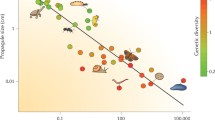Summary
The basis for measuring differentiation among subpopulations is discussed and a number of conditions formulated that are desirable for an appropriate measure. These conditions imply that each subpopulation is characterized by the difference in genetic composition between it and its complement. A direct method of determining this difference is described and shown to result from a known measure of genetic distance between populations. The weighted average of the genetic distances between subpopulations and their complements constitutes a measure of differentiation among subpopulations which fulfills all of the desirable conditions and has the additional advantage that its values are directly interpretable. This measure (δ) is equally applicable to gene (δ ge ), gametic (δ ga ) or genotypic (δ go ) frequencies, which guarantees an unequivocal multilocus treatment, provided that the sets of genetic entities to which the frequencies refer are properly defined. The general relationship δ ge ≤ δ ga ≤ δ go is consistent with the principle that increasing complexity of organization of genetic material results in increased opportunity for differentiation. It is demonstrated that Wright's F st (G ST in Nei's notation), which is often used to measure subpopulation differentiation, meets some but not all of the conditions formulated for a desirable measure.
Similar content being viewed by others
References
Ehrlich PR, Raven PH (1969) Differentiation of populations. Science 165:1227–1232
Gregorius H-R (1974) Genetischer Abstand zwischen Populationen. 1. Zur Konzeption der genetischen Abstandsmessung. Silvae Genet 23:22–27
Gregorius H-R (1984) A unique genetic distance. Biom J 26:13–18
Hamrick JL (1983) The distribution of genetic variation within and among natural plant populations. In: Schonewald-Cox CM, Chambers SM, MacBride B, Thomas L (eds) Genetics and conservation. Benjamin/Cummings, Menlo Park, pp 335–349
Linhart YB, Mitton JB, Sturgeon KB, Davis ML (1981) Genetic variation in space and time in a population of ponderosa pine. Heredity 46:407–426
Müller G (1976) A simple method of estimating rates of self-fertilization by analyzing isozymes in tree seeds. Silvae Genet 25:15–17
Wright S (1969) Evolution and the genetics of populations, vol 2. University of Chicago Press, Chicago
Wright S (1978) Evolution and the genetics of populations, vol 4. University of Chicago Press, Chicago
Author information
Authors and Affiliations
Additional information
Communicated by P. M. A. Tigerstedt
Rights and permissions
About this article
Cite this article
Gregorius, H.R., Roberds, J.H. Measurement of genetical differentiation among subpopulations. Theoret. Appl. Genetics 71, 826–834 (1986). https://doi.org/10.1007/BF00276425
Received:
Accepted:
Issue Date:
DOI: https://doi.org/10.1007/BF00276425




